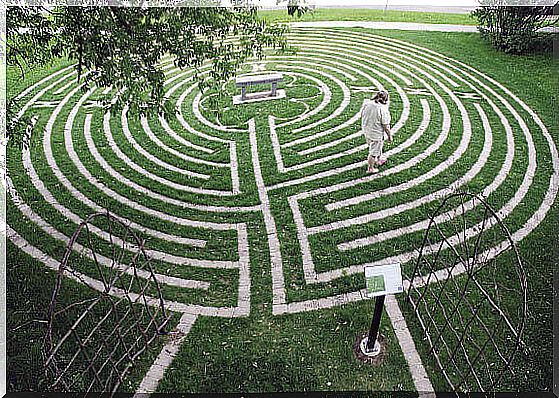Learn To Meditate While Walking

There are those who never manage to learn to meditate. Your mind does not tune into this still calm to practice mindfulness, to acquire a deep state of stillness. However, something as easy as starting to walk can transform your life: it lifts your spirits and your mind is freed almost instantly.
We have already mentioned that therapeutic approaches, such as mindfulness, are not usually useful for everyone. Teenagers or even people with high anxiety or who have suffered some kind of trauma do not end up reaching this perfect point of relaxation to learn to be more aware of their inner world through a relaxed state.
When the mind screams, when our thoughts are obsessive and we have all our worries stuck like an iron crust on our being, there is a strategy that almost never fails: walking. In fact, there is something magical about the simple act of walking. The movement of our body is like the metronome that marks a compass, a perfect rhythm in which sooner or later the mind itself is harmonized, forming the same entity. The same song .
With each step the heart grows, breathing becomes deep, sonorous, the brain oxygenates and our being expands through these repetitive movements to reach its point of balance. This is how you take charge of your life through this physical exercise that combines meditation.
Below we offer more information on the topic. We are sure they will be of great use.

Meditating While Walking: A Rewarding Means To A Healthy Goal
When a psychologist decides to integrate mindfulness into psychotherapy, he does not seek to convert his clients into skilled spiritual meditators, nor does he seek to convince them to spend their weekends in Buddhist silence retreats. None of that. It is a means to a goal, a tool where people can live their lives with more balance and with a broader awareness.
But the most complex thing about meditation is that it requires responsibility and willpower. If it’s no longer easy to isolate the sound of our environment and the noise of cities, it’s even harder to shut your mind. That is why this new approach is currently applied, which could be summarized in an illustrative word that comes from the Sanskrit “ apranihita ”, walking without arriving. Starting to walk without having a specific destination allows us to enjoy simple movement more than ever. We walk for the simple pleasure of walking.
The human mind is almost like a restless monkey jumping from branch to branch on a chaotic, nervous and unproductive journey. Almost without knowing how, we ended up lost in our own labyrinths. However, if we can alleviate this nervousness through the rhythm of our legs and breathing to accompany the rhythm of each step, we will be able to achieve this conscious control of thoughts.

How to learn to meditate while walking
Our tour must be daily and no longer than half an hour. But it is necessary that we do it in a natural, quiet space and that we wear comfortable shoes and clothing.
- Start walking at normal steps. Gradually you should find the rhythm that is most relaxing, most cathartic, and most liberating. There are those who walk at a slow pace and those who decide to start a faster march.
- It’s time to focus your attention on some aspect. Visualize your mind as a flashlight that directs its light on one specific aspect and then another: first your breathing, then the feeling of your feet as they touch the ground, later the wind that caresses your skin… Focus your attention to these aspects in a cyclic way, first one and then the other.
- You will gradually find that you no longer need to focus your attention on each of these aspects of your body. At the end of the day, your flashlight’s focus will be so wide that you’ll notice everything at once.
Your consciousness will have expanded so much that your being will form a perfect whole, in calm and harmony.
Walking in a maze: the magic of concentration
Let’s go a little further now. Let’s imagine that in your case mindfulness is not helpful and you also cannot learn to meditate while walking. The simple fact of leaving the house and walking without a fixed direction distracts you, disperses your mind and you cannot find your point of balance, your center, your point of calm.
In this case, we can start a curious and ancient practice in many cultures: traversing a labyrinth. This ancient practice is like visualizing your own problems tattooed on the floor and going through them step by step as you find a way out. It is known that some of the simplest forms of labyrinths are found in Greece and were intended to find meaning in life itself through spiral circuits.

It was another type of meditation that, nowadays, people continue to practice in different countries. Let’s see some more facts about the topic:
- In labyrinths there is no single way out, nor is it “win” when the person manages to get out of it. The benefit is in the very act of walking through it and in what we achieve while going through it.
- The aim is to “ soothe the mind, open the heart ” through the exercise itself.
- When entering a labyrinth, you must first stop and reflect, thinking about what we should let go of before starting this concentric journey so that we can fully focus on the present, the here and now.
- The right thing is to walk slowly, putting one foot in front of the other and seeing at all times the shape of the lines, the paths.
When reaching the center or the “rosette” of the labyrinth, the person should rest and meditate for a few minutes on the path taken. The purpose of this exercise is not to find a way out of the tangle of our problems, but to come out strengthened by the learning gained during this process.
A curious exercise that never hurts to know.









